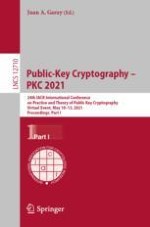2021 | OriginalPaper | Chapter
Universal Proxy Re-Encryption
Authors : Nico Döttling, Ryo Nishimaki
Published in: Public-Key Cryptography – PKC 2021
Publisher: Springer International Publishing
Activate our intelligent search to find suitable subject content or patents.
Select sections of text to find matching patents with Artificial Intelligence. powered by
Select sections of text to find additional relevant content using AI-assisted search. powered by
Abstract
-
provide syntax and definitions for both UPRE and a variant we call relaxed UPRE. The relaxed variant means that decryption algorithms for re-encrypted ciphertexts are slightly modified but still only use the original delegatee secret keys for decryption.
-
construct a UPRE based on probabilistic indistinguishability obfuscation (PIO). It allows us to re-encrypt ciphertexts polynomially many times.
-
construct relaxed UPRE from garbled circuits (GCs). We provide two variants of this construction, one which allows us to re-encrypt ciphertexts polynomially many times, and a second one which satisfies a stronger security requirement but only allows us to re-encrypt ciphertexts a constant number of times.
